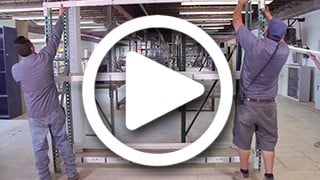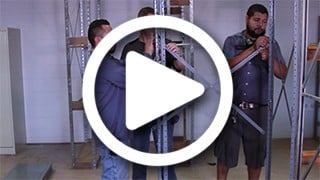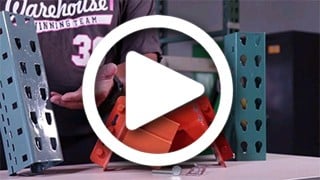Warehouse Pallet Rack Guide: Benefits, Use Cases, Safety & Specifications
Are you trying to determine how to buy the optimal pallet racking system for your warehouse floor, distribution center, manufacturing plant, or storage facility? It's not always an easy task, and there are several things you should consider before making a big purchase. It's important to plan certain things ahead of time, such as:
- Rack types
- Usability
- Dimensions
- Components
- Accessories
- Wire decking
- Load capacity
- Available space

What Are Warehouse Pallet Racks?
Pallet racks are material handling storage systems that, along with proper SKU implementation, keep palletized products organized within warehouses. These racks consist of sturdy metal frames and horizontal beams, providing a stable structure to support pallets stacked with products. They are typically arranged in rows and columns and efficiently utilize vertical space to maximize warehouse storage capacity. They are versatile and adaptable, allowing for various configurations to meet specific storage needs within a warehouse’s available space.
These racks consist of sturdy metal frames and horizontal beams, providing a stable structure to support pallets stacked with products. They are typically arranged in rows and columns and efficiently utilize vertical space to maximize warehouse storage capacity. They are versatile and adaptable, allowing for various configurations to meet specific storage needs within a warehouse’s available space.
Warehouse pallet racks come in various configurations and designs that cater to unique storage requirements and operational environments. For example, selective pallet racks offer easy access to individual pallets, making them ideal for warehouses with frequent inventory turnover. On the other hand, high-density pallet rack systems are suitable for storing large quantities of products with lower turnover rates.
Warehouse1 offers a large selection of racks, so you can easily find options that meet your business needs and requirements.
Key Benefits and Use Cases
When used correctly, storage racking systems increase storage density, warehouse space, and aisle space by enabling you to put as many pallets into a single place as possible, while maintaining easy access to the items stored on them. This helps reduce storage costs and improves operational efficiency by minimizing the need for excessive floor space. Another key benefit of racking systems is improved organization and inventory management. When deployed correctly, the risk of overstocking, stockouts, and product damage is greatly reduced, further boosting productivity, cost-savings, and safety.
The use cases for warehouse pallet racks are extensive and span numerous industries. Any industry that relies on large quantities of product to be available at any given time almost certainly leverages pallet racks. Here are just a few use cases for pallet racking systems:
- Manufacturing Facilities: Pallet racking systems are used in the manufacturing industry to store raw materials and finished goods during the production process. Efficient use of space is critical in a manufacturing warehouse as there are often a lot of products moving through the manufacturing line.
- Distribution Centers: Optimized space utilization and facility flow is crucial for distribution centers. Pallet racks allow this industry to improve shipping times and reduce product damage.
- Healthcare: In the healthcare industry, products ranging from large equipment to small supplies are utilized, emphasizing the need for proper, sterile storage and convenient, quick access to healthcare supplies. Pallet racks allow the healthcare industry to swiftly access life-saving products and safely store them.
- Automotive: The automotive industry relies on easy access to a plethora of products. Whether a small repair shop or a large vehicle production operation, this industry has many SKUs and leverages pallet racks to organize and store all the parts needed.
- Food Industry: Food must be stored efficiently while also providing sanitary conditions. Pallet racks are essential for the storage and preservation of perishable goods, ensuring compliance with stringent food safety regulations.
Common Types of Pallet Racking Systems
Most warehouses utilize racking systems to maximize available storage and floor space, the most popular type of selective rack being teardrop pallet racks. Within the category of pallet racks, there are a number of different rack designs to choose from, depending on the size of your space, the specific warehouse layout, the items you'll be storing, and the material handling equipment you plan to use. The following are a few common types:
Selective Rack
Selective pallet racks are the most popular types of warehouse racking. Horizontal load beams connect to vertical uprights to provide storage space and structural support. The open design enables pickers to access any pallet at any time.
Drive-In Pallet Racking
Drive-in racks maximize the warehouse ground space by utilizing a LIFO (last-in, first-out) approach. These racks don’t require as many aisles as other options, but they’re able to deliver the same storage capacity. They're designed to allow forklifts to easily navigate the aisles so they can continue stacking and adding more pallets.
h3>Drive-Through Racks
Drive-through racking provides great storage capacity and consists of aisles wide enough for forklifts or other machinery to drive through. Pallets are stored in a FIFO (first-in, first-out) manner. This is an ideal system for warehouses that have high volume and high product rotation.
Pushback Pallet Racking
Pushback racks provide high-density pallet storage while also incorporating a LIFO (last-in, first-out) rotation. Pallets are placed on a cart in a storage bay. When a picker places another pallet, the first one "pushes back" deeper into the system.
Pallet Flow Racking
Pallet flow racking is usually ideal for storage loads that are dense and heavy and have numerous order picking sections. These racks employ the FIFO (first-in, first-out) loading system, ensuring products are continually rotated.
Carton Flow Racking
Carton flow racks also offer a FIFO approach to the inventory. These systems utilize rear-load designs that enable easy operation and management of inventory. Unlike pallet flow racks, this system is designed for hand picking and stocking boxes and cartons instead of palletized loads.
Wire Decks, Beam Capacity & Load Distribution
When determining how a pallet rack will be loaded, there are more considerations than just weight, number of pallets, and rack structure. The specifications of the load (dimensions, shape, size, and density) must also be taken into consideration. ANSI 26.2 and other universally accepted load distribution regulations have been put into place to ensure "any static load which is evenly distributed over the entire surface on the rack deck [is] independent of the support system."
When selecting the right wire deck for your specific project, it is essential to know not only the weight but also the type of load. Loads could vary from wood or plastic pallets, Gaylord boxes, hand stack applications, furniture, or any number of other possibilities. Local fire codes should also be considered.

Types of Load Distribution
When purchasing decking for your pallet rack system, different types of load distribution should be considered, based upon your specific requirement.
Uniformly Distributed Load (UDL)
A UDL is a load that's distributed evenly across the whole region of a beam or slab. The load remains uniform throughout the element. This is the safest type of load distribution and is recommended for pallet storage.
Line Load
Line load refers to any static load that distributes its weight in a concentrated line.
Concentrated Load
Any load that's not uniformly distributed over the entire surface of the decking section is converted to a concentrated load. In these cases, the weight of the pallet is placed at the center of the deck, and the entire load is supported by channels that leave the outer support beams untouched. Warehouse1 cautions against storing loads in this manner unless storing light weight products.
Point Load
A point load is defined as any load that has a concentrated weight that rests on individual points. An example would be a five-point pallet that's resting on a four-foot deck; the points of the pallet are specifically placed in a way that distributes the weight where it needs to be.
Other Common Pallet Rack Accessories
When it comes to creating the optimal inventory storage and warehouse management system, you'll also want to consider rack accessories you may need, such as the following:
Column Guards
Column guards, also known as post protectors, are protective barriers that are installed around upright posts. They serve to minimize damage if forklifts collide with the columns.
Floor Shims
Floor shims are important because they enable uprights to be leveled out on uneven floors.
Fork Bars
Fork bars give you the ability to load and unload non-palletized storage products with a forklift. Fork bars are often called forklift clearance bars or fork clearance bars.
Load Stops
Load stops are used to prevent pallets from falling over the backside of the racks they're stacked onto, keeping inventory from getting damaged. Load stops are brackets that attach to the beams.
Rack Backs & Safety Netting
Rack backs and safety netting are used to both increase employee safety and protect inventory. They work by preventing material from falling off the racks. They're commonly installed along the backside of racks in areas along the main aisles.
Row Spacers
Row spacers create consistent spacing for back-to-back racking while providing greater stability to the system and creating an all-around safer work environment.
Pallet Supports
Pallet supports are a must-have accessory if you have pallets that are not deep enough for your current setup. They add greater flexibility to vertical rack systems so you can accommodate products that vary extensively in size.
Wall Ties
Wall ties are easily installed and help steady pallet racks that would otherwise be standalone systems. Wall ties join the rack to the adjacent wall, increasing the stability of the overall structure.
Specialty Racks
Cantilever Rack
Cantilever racking is a storage system that's designed to store long, awkward, or bulky materials. These systems consist of upright columns, which connect to the base and have holes in which the cantilever arms are connected to create the storage levels.
Bar Storage Rack
Bar storage racks, also known as bar racks, come in both vertical and horizontal designs. They're great for storing bar stock, pipe, or tubing quickly and efficiently.
Barrel Rack
Storage of wine, whiskey, and vodka casks isn't so easy on standard pallet racks, which is why barrel racks were invented. Barrel racks enable you to fully utilize your vertical space and achieve greater selectivity for picking each barrel individually.
Reel Rack
Reel racks are useful for storing and dispensing wire, rope, hose, electrical cable, and chains.
Roll Out Shelf Rack
Roll out shelf racks make it easier for you to load and unload shelves because the shelving units are mobile and accessible. They are useful for storing tools and any item that requires quick, easy access.
Stack Racks
Stack racks are useful in storing, transporting, and stacking materials. They're accessible by fork trucks from four sides and can stack up to four racks high.
Steel Stacks
Steel stacks are useful for holding bar stock, pipes, tubing, specialty lumber, and various parts. They can also be stacked up to four high.
U-Racks
U-racks are used to place bar and pipe stock by providing a modular, low-cost storage option.
Vertical Storage Racks
Vertical storage racks are great for storing sheet material, plates, panels, and other on-edge elements. They can store up to 12'- and 6'-wide materials.
Storing Difficult, Bulky, & Long Loads
Not all materials fit into the storage options we've listed so far - this includes items such as rolls, reels, and other spooling loads. The right equipment will enable you to store this type of material on heavy-duty racks with strong durability. It may require special reel pockets and placement devices, but Warehouse1 has you covered in those areas. Rolled items can easily be dispensed with the right pallet equipment, but you need to understand their capacities.

Long-item storage can also be a difficult item to handle. Many long items can be stored on cantilevers instead of racks. Pallet racks could be a better option, depending on the storage strategy of your facility. It also depends on what's being stored. For example, long rolls of film or fabric can't be stored on cantilever arms because the arm could dent the fragile materials; in this case, full support is needed, which is where a pallet racking system comes in.
Pallet Rack Tips
Loading and Unloading Tall Racks
Loading and retrieving pallets is difficult because forklift drivers can't see the load or the rack beam. Here are a few tips to help ensure the safety of your team:
- Load the rack with adequate clearance
- Add technology to help drivers see
- Install product/pallet fall-protection systems
How to Inspect Pallet Racks
To prevent unexpected injuries, it's important to regularly examine your pallet racks for damaged components, split welds, corrosion, and indentations. Racks need to be straight, within plumb ratio regulations, and should be bolted to the floor to achieve their full capacity. Also, be sure to check the following elements:
- Rack upright frames and base plates
- Load beams
- Deformed struts or braces
- Rack environment and usage
OSHA Regulations
There are two primary federal OSHA regulations applicable to storage racks: 1910.176(b) and 1910.159. The former states that stored items must be secured. While it doesn't necessarily address racking, it does generally state that materials must be stacked properly to keep materials from falling over or collapsing. The latter deals with the height of any storage materials in relation to fire sprinklers. Racked materials must be at least 18 inches from sprinkler systems.
Flue Space & Fire Prevention
Flue spaces are unobstructed vertical sightlines existing between the floor and ceiling within rack storage areas. Flue space allows heat from a fire to vent upward so it can properly activate sprinkler systems, preventing fires from spreading across entire warehouses. The National Fire Protection Association (NFPA) Code 13 shows the results of several tests that point to the dangers that occur when flue spaces are blocked. Pallet straps, netting, and pallet load stop beams can all help prevent obstructions to flue spaces.
Fire suppression systems affect rack structure design and geometry, so your system must be carefully planned for safety.
The Warehouse1 Way
It's important to have the right warehouse racking system and dimensions planned out in advance. Knowing what you need the storage equipment for—and how you'll be using it—will help ensure you have the proper equipment for your unique needs. We invite you to shop Warehouse1's selection of pallet racks today! If you need help figuring out where to go from here, contact us, or check out our layout checklist, as well as our layout design and warehouse relocation services. We look forward to helping you find the right storage solution for your facility!


























